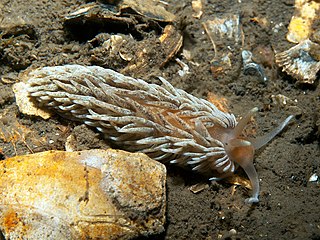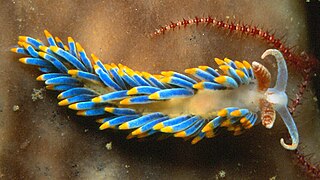
Aeolidiidae, a family of aeolid nudibranchs, are a family of sea slugs, shell-less marine gastropod molluscs.

Aiptasia is a genus of a symbiotic cnidarian belonging to the class Anthozoa. Aiptasia is a widely distributed genus of temperate and tropical sea anemones of benthic lifestyle typically found living on mangrove roots and hard substrates. These anemones, as well as many other cnidarian species, often contain symbiotic dinoflagellate unicellular algae of the genus Symbiodinium living inside nutritive cells. The symbionts provide food mainly in the form of lipids and sugars produced from photosynthesis to the host while the hosts provides inorganic nutrients and a constant and protective environment to the algae. Species of Aiptasia are relatively weedy anemones able to withstand a relatively wide range of salinities and other water quality conditions. In the case of A. pallida and A. pulchella, their hardiness coupled with their ability to reproduce very quickly and out-compete other species in culture gives these anemones the status of pest from the perspective of coral reef aquarium hobbyists. These very characteristics make them easy to grow in the laboratory and thus they are extensively used as model organisms for scientific study. In this respect, Aiptasia have contributed a significant amount of knowledge regarding cnidarian biology, especially human understanding of cnidarian-algal symbioses, a biological phenomenon crucial to the survival of corals and coral reef ecosystems. The dependence of coral reefs on the health of the symbiosis is dramatically illustrated by the devastating effects experienced by corals due to the loss of algal symbionts in response to environmental stress, a phenomenon known as coral bleaching.

Aeolidia papillosa, known as the common grey sea slug, is a species of nudibranch in the family Aeolidiidae.

Aeolidiella is a genus of sea slugs, aeolid nudibranchs, marine gastropod molluscs in the family Aeolidiidae.

Spurilla is a genus of sea slugs, aeolid nudibranchs, marine gastropod mollusks in the family Aeolidiidae.
Berghia verrucicornis is a species of sea slug, an aeolid nudibranch. It is a shell-less marine gastropod mollusc in the family Aeolidiidae.

Berghia is a genus of sea slugs, aeolid nudibranchs. They are shell-less marine gastropod molluscs in the family Aeolidiidae. They are covered in cerata which give them their unique tentacle look and color. Berghia are commonly found in shallow waters and their diet consists of strictly Aiptasia Anemone. This genus is now commonly used commercially to fight off Anemone populations in fish tanks.
Berghia rissodominguezi is a species of sea slug, an aeolid nudibranch. It is a shell-less marine gastropod mollusc in the family Aeolidiidae.

Berghia norvegica is a species of sea slug, an aeolid nudibranch. It is a shell-less marine gastropod mollusc in the family Aeolidiidae.
Berghia marcusi is a species of sea slug, an aeolid nudibranch. It is a shell-less marine gastropod mollusc in the family Aeolidiidae.
Berghia creutzbergi is a species of sea slug, an aeolid nudibranch. It is a shell-less marine gastropod mollusc in the family Aeolidiidae.
Berghia columbina is a species of sea slug, an aeolid nudibranch. It is a shell-less marine gastropod mollusc in the family Aeolidiidae.
Berghia dakariensis is a species of sea slug, an aeolid nudibranch. It is a shell-less marine gastropod mollusc in the family Aeolidiidae.

Berghia stephanieae is a species of sea slug, an aeolid nudibranch. It is a marine gastropod mollusc in the family Aeolidiidae. It was previously known as Aeolidiella stephanieae.
Berghia marinae is a species of sea slugs, an aeolid nudibranch. It is a shell-less marine gastropod mollusc in the family Aeolidiidae.

Spurilla neapolitana, the Neapolitan spurilla, is a species of sea slug, an aeolid nudibranch, a marine gastropod mollusk in the family Aeolidiidae. It is native to the western Atlantic Ocean, the Caribbean Sea and the Mediterranean Sea. This species was first described as Eolis neapolitana by the Italian naturalist Stefano delle Chiaje in 1841. However, although some authorities quote the year as 1823, the species does not appear in the first volume of delle Chiaje's memoirs, which was published that year. The species was later reassigned to the genus Spurilla.
Cerberilla bernadettae is a species of sea slug, an aeolid nudibranch, a marine heterobranch mollusc in the family Aeolidiidae.

Aeolidiella alderi is a species of sea slug, an aeolid nudibranch in the family Aeolidiidae. It is native to northwestern Europe where it occurs in the intertidal zone. It is a predator and feeds on sea anemones.
Spurilla braziliana is a species of sea slug, an aeolid nudibranch. It is a shell-less marine gastropod mollusc in the family Aeolidiidae.

Exaiptasia is a genus of sea anemone in the family Aiptasiidae, native to shallow waters in the temperate western Atlantic Ocean, the Caribbean Sea and the Gulf of Mexico. It is monotypic with a single species, Exaiptasia diaphana, and commonly known as the brown anemone, glass anemone, pale anemone, or simply as Aiptasia.









